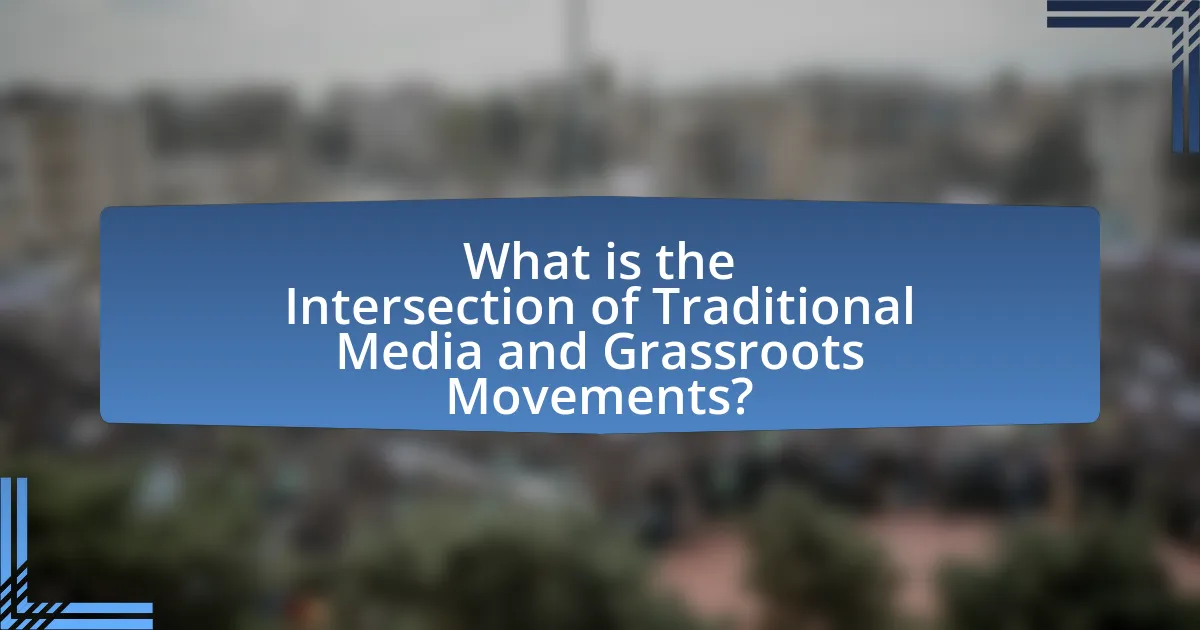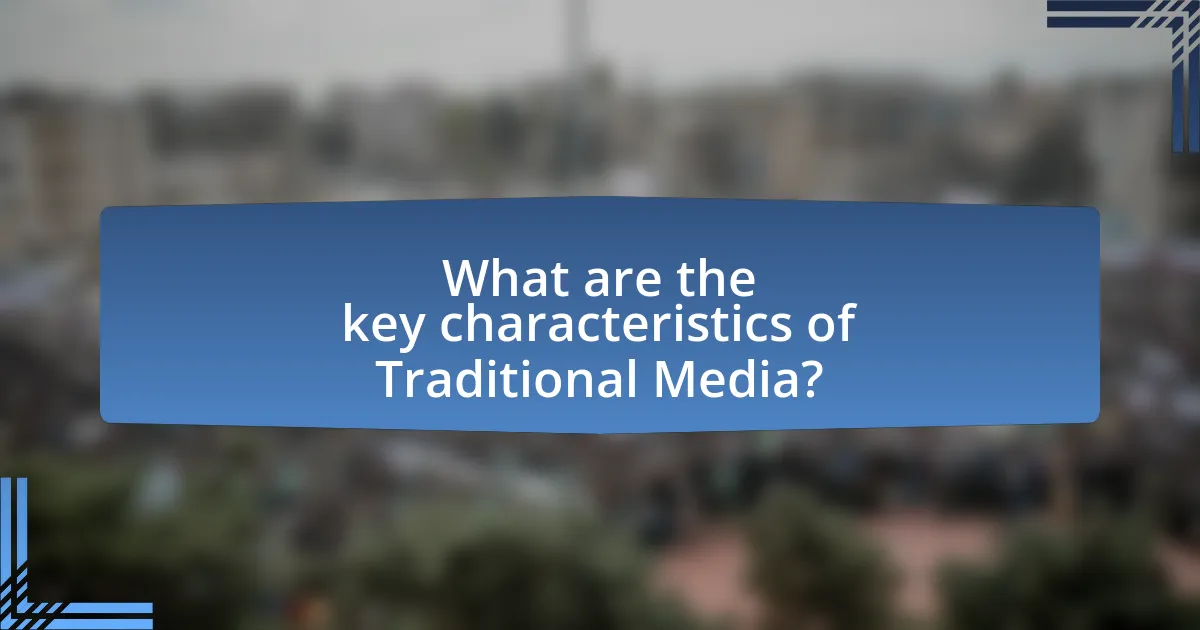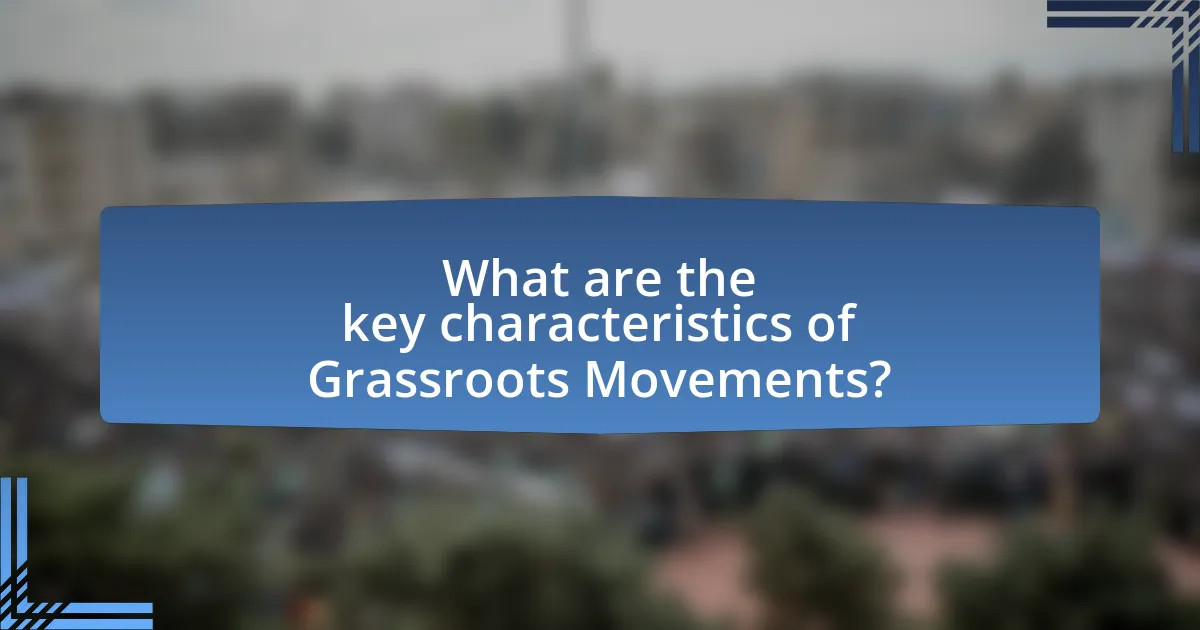The article examines the intersection of traditional media and grassroots movements, highlighting how grassroots initiatives utilize established media platforms to amplify their messages and reach wider audiences. It discusses the reciprocal relationship between these entities, where traditional media provides visibility and legitimacy to grassroots movements, while grassroots efforts offer compelling narratives that traditional media can cover. Key aspects include the roles of traditional media in shaping public perception, the challenges faced by grassroots movements in gaining media coverage, and effective strategies for collaboration between the two. The article emphasizes the significance of this intersection in fostering social change and enhancing community engagement around critical social issues.

What is the Intersection of Traditional Media and Grassroots Movements?
The intersection of traditional media and grassroots movements occurs when grassroots initiatives leverage established media platforms to amplify their messages and reach broader audiences. Traditional media, including newspapers, television, and radio, can provide significant visibility to grassroots movements, which often rely on these channels to disseminate information, mobilize support, and influence public opinion. For example, the Civil Rights Movement in the 1960s utilized television coverage to highlight injustices, leading to increased national awareness and support. This synergy allows grassroots movements to gain legitimacy and traction, while traditional media benefits from engaging content that resonates with audiences seeking social change.
How do traditional media and grassroots movements interact?
Traditional media and grassroots movements interact through a reciprocal relationship where traditional media amplifies grassroots messages while grassroots movements provide content and narratives that traditional media may cover. Traditional media outlets often report on grassroots initiatives, bringing visibility to social issues and mobilizing public support, as seen in the coverage of movements like Black Lives Matter, which gained significant attention through news reports and social media. Conversely, grassroots movements leverage traditional media to reach broader audiences, utilizing press releases and media events to attract coverage, thereby influencing public discourse and policy. This interaction is crucial for raising awareness and fostering community engagement around social causes.
What roles do traditional media play in grassroots movements?
Traditional media plays a crucial role in grassroots movements by providing visibility, shaping narratives, and mobilizing support. Through coverage in newspapers, television, and radio, traditional media amplifies the voices of grassroots activists, allowing their messages to reach a broader audience. For instance, the civil rights movement in the 1960s gained significant traction due to extensive media coverage, which highlighted injustices and garnered public sympathy. Additionally, traditional media can influence public opinion and policy by framing issues in a way that resonates with the audience, as seen in various environmental movements that have successfully leveraged media attention to advocate for policy changes.
How do grassroots movements influence traditional media narratives?
Grassroots movements influence traditional media narratives by shaping public discourse and providing alternative perspectives that challenge mainstream narratives. These movements often utilize social media platforms to mobilize support, raise awareness, and generate content that traditional media outlets may later adopt or respond to. For instance, the Black Lives Matter movement significantly impacted media coverage of racial issues, leading to increased visibility of systemic racism and police brutality in news reporting. Research by the Pew Research Center indicates that social media has become a primary source of news for many individuals, allowing grassroots movements to directly engage with audiences and influence the framing of stories in traditional media.
Why is the intersection of these two entities significant?
The intersection of traditional media and grassroots movements is significant because it amplifies the voices of marginalized communities and enhances the visibility of social issues. Traditional media platforms, such as television and newspapers, provide a broad reach that grassroots movements often lack, allowing for increased public awareness and engagement. For instance, the coverage of the Black Lives Matter movement by major news outlets has led to widespread discussions on racial injustice, influencing public opinion and policy changes. This synergy between traditional media and grassroots activism creates a powerful mechanism for social change, as evidenced by the increased support for various movements following their portrayal in mainstream media.
What impact does this intersection have on public perception?
The intersection of traditional media and grassroots movements significantly shapes public perception by amplifying grassroots messages and increasing visibility for social issues. Traditional media platforms, such as television and newspapers, provide a broader audience reach, allowing grassroots movements to disseminate their narratives effectively. For instance, coverage of movements like Black Lives Matter in mainstream media has led to heightened awareness and support for racial justice issues, as evidenced by increased public engagement and participation in protests following media coverage. This synergy between traditional media and grassroots activism not only informs the public but also influences societal attitudes and policy discussions, demonstrating the powerful role of media in shaping perceptions around social movements.
How does it affect the success of grassroots initiatives?
The success of grassroots initiatives is significantly affected by the level of visibility and engagement they receive through traditional media. Traditional media platforms, such as newspapers, television, and radio, can amplify the message of grassroots movements, reaching a broader audience and increasing public awareness. For instance, a study by the Pew Research Center found that 62% of Americans get their news from social media, which often intersects with traditional media coverage, thereby enhancing the reach of grassroots campaigns. This increased visibility can lead to greater community support, funding opportunities, and political influence, ultimately contributing to the effectiveness and sustainability of grassroots initiatives.

What are the key characteristics of Traditional Media?
Traditional media is characterized by its one-way communication, established formats, and mass reach. This form of media, which includes television, radio, newspapers, and magazines, primarily disseminates information from a central source to a broad audience without direct interaction. Traditional media typically follows structured formats, such as scheduled broadcasts or printed editions, which are designed for mass consumption. Furthermore, it has a significant ability to reach large demographics simultaneously, making it a powerful tool for shaping public opinion and influencing grassroots movements. For instance, during major events like elections, traditional media outlets can provide extensive coverage that informs and mobilizes the public, demonstrating their role in societal engagement.
How has traditional media evolved over time?
Traditional media has evolved significantly from print newspapers and radio broadcasts to include television and digital platforms. Initially, traditional media primarily consisted of print publications, which dominated the landscape until the mid-20th century when television emerged as a powerful medium, reshaping how information was disseminated. By the late 20th century, the advent of the internet introduced digital media, allowing for instantaneous news delivery and audience interaction. This transition has led to a decline in print circulation and a shift towards online news consumption, with statistics showing that as of 2021, over 60% of adults in the U.S. accessed news online, highlighting the transformation in media consumption habits.
What are the main forms of traditional media?
The main forms of traditional media are print media, broadcast media, and outdoor media. Print media includes newspapers and magazines, which have historically been primary sources of information for the public. Broadcast media encompasses television and radio, which provide audio-visual content to a wide audience. Outdoor media refers to billboards and posters, which are used for advertising and public announcements. These forms of traditional media have played significant roles in shaping public opinion and disseminating information throughout history.
How do traditional media platforms differ in their approach to news coverage?
Traditional media platforms differ in their approach to news coverage by prioritizing established journalistic standards and editorial oversight, while often focusing on broader audience reach and advertising revenue. Traditional outlets, such as newspapers and television networks, typically employ professional journalists who adhere to ethical guidelines, fact-checking processes, and structured reporting formats. For instance, the Associated Press and BBC have rigorous editorial standards that ensure accuracy and impartiality in their news reporting. In contrast, grassroots movements often utilize social media and alternative platforms to disseminate information rapidly, emphasizing immediacy and personal narratives over formal verification. This difference highlights how traditional media aims for credibility and authority, while grassroots movements prioritize accessibility and community engagement in their news coverage.
What challenges does traditional media face in the context of grassroots movements?
Traditional media faces significant challenges in the context of grassroots movements, primarily due to its reliance on established narratives and gatekeeping practices. Grassroots movements often prioritize authenticity and direct communication, which can conflict with traditional media’s structured reporting and editorial oversight. For instance, traditional media outlets may struggle to accurately represent the diverse voices within grassroots movements, leading to oversimplification or misrepresentation of their goals and messages. Additionally, the rapid dissemination of information through social media platforms allows grassroots movements to bypass traditional media channels, diminishing the latter’s influence and relevance. This shift is evidenced by the rise of movements like Black Lives Matter, which gained momentum largely through social media rather than traditional news coverage.
How do financial pressures affect traditional media’s coverage of grassroots issues?
Financial pressures significantly limit traditional media’s coverage of grassroots issues by prioritizing profitability over comprehensive reporting. As advertising revenues decline, media outlets often reduce their budgets, leading to fewer resources allocated for investigative journalism and local reporting. For instance, a study by the Pew Research Center in 2020 found that nearly 1,800 local newspapers in the United States have closed since 2004, resulting in diminished coverage of community issues, including grassroots movements. Consequently, traditional media may focus on sensational stories or larger events that attract more viewers, neglecting the nuanced and critical coverage that grassroots issues require.
What biases exist within traditional media that impact grassroots movements?
Traditional media exhibits several biases that significantly impact grassroots movements, including framing bias, selection bias, and access bias. Framing bias occurs when media outlets present issues in a way that emphasizes certain aspects while downplaying others, which can shape public perception and influence the narrative surrounding grassroots initiatives. For example, coverage of protests may focus on violence or disruption rather than the underlying social issues, skewing public understanding.
Selection bias refers to the tendency of media to choose which stories to cover, often favoring those that align with mainstream interests or sensationalism, thereby marginalizing grassroots movements that lack visibility or resources. This can lead to underrepresentation of diverse voices and perspectives, limiting the reach and effectiveness of these movements.
Access bias arises when traditional media grants more coverage to established organizations or individuals with connections, sidelining grassroots groups that may lack media relations expertise. This disparity can hinder the ability of grassroots movements to gain traction and support, as their messages may not reach a broader audience. Collectively, these biases create barriers for grassroots movements, affecting their visibility, public perception, and overall impact.

What are the key characteristics of Grassroots Movements?
Grassroots movements are characterized by their community-driven nature, emphasizing local participation and activism. These movements typically arise from the collective efforts of individuals at the local level, seeking to address specific social, political, or environmental issues. They often rely on informal networks and direct action rather than formal organizational structures, allowing for flexibility and adaptability. Additionally, grassroots movements prioritize inclusivity and empowerment, encouraging marginalized voices to participate in decision-making processes. Historical examples, such as the Civil Rights Movement in the United States, illustrate how grassroots efforts can lead to significant societal change, demonstrating the effectiveness of localized activism in challenging systemic injustices.
How do grassroots movements organize and mobilize?
Grassroots movements organize and mobilize through community engagement, decentralized leadership, and the use of social media platforms. These movements often begin by identifying a common issue that resonates with a local community, which fosters collective action. Organizers typically utilize face-to-face meetings, community events, and online forums to build networks and encourage participation.
For instance, the Black Lives Matter movement effectively mobilized supporters through social media campaigns, which allowed for rapid dissemination of information and coordination of protests. According to a study by the Pew Research Center, 53% of Americans reported that social media played a crucial role in their awareness of social movements, highlighting its significance in grassroots mobilization. This combination of local engagement and digital outreach enables grassroots movements to adapt quickly and respond to emerging issues, thereby enhancing their effectiveness.
What strategies do grassroots movements use to gain visibility?
Grassroots movements use social media campaigns, community organizing, and public demonstrations to gain visibility. Social media platforms allow these movements to reach a wide audience quickly, facilitating the sharing of messages and mobilizing supporters. For instance, the #MeToo movement effectively utilized Twitter to amplify voices and raise awareness about sexual harassment, resulting in significant media coverage and public discourse. Community organizing involves building local networks and engaging individuals directly, which fosters a sense of ownership and commitment among participants. Public demonstrations, such as marches and rallies, attract media attention and can lead to broader public engagement, as seen in the Women’s March in 2017, which drew millions globally and highlighted issues of gender equality. These strategies collectively enhance visibility and influence public opinion.
How do grassroots movements leverage social media alongside traditional media?
Grassroots movements leverage social media alongside traditional media by using social platforms for rapid communication and mobilization while utilizing traditional media for broader reach and credibility. Social media allows grassroots organizations to engage directly with supporters, share real-time updates, and organize events quickly, exemplified by movements like Black Lives Matter, which effectively used Twitter and Facebook to coordinate protests and disseminate information. Traditional media, such as newspapers and television, provides legitimacy and can amplify the message to a wider audience, as seen when grassroots campaigns secure coverage in major outlets, thereby attracting more attention and support. This dual strategy enhances visibility, fosters community engagement, and increases the overall impact of their initiatives.
What challenges do grassroots movements encounter with traditional media?
Grassroots movements encounter significant challenges with traditional media, primarily due to limited coverage and misrepresentation. Traditional media often prioritizes mainstream narratives, which can lead to underreporting of grassroots initiatives. For instance, a study by the Pew Research Center found that only 27% of local news stories cover community issues, leaving grassroots movements struggling for visibility. Additionally, traditional media may frame these movements in ways that distort their messages, focusing on sensational aspects rather than the core issues they address. This misrepresentation can hinder public support and understanding, ultimately affecting the effectiveness of grassroots efforts.
How do grassroots movements combat misrepresentation in traditional media?
Grassroots movements combat misrepresentation in traditional media by utilizing social media platforms to amplify their narratives and counteract biased portrayals. These movements often create their own content, such as videos, articles, and infographics, which provide alternative perspectives that challenge mainstream media narratives. For instance, during the Black Lives Matter protests, activists used platforms like Twitter and Instagram to share real-time updates and personal stories, effectively bypassing traditional media filters. This approach not only raises awareness but also mobilizes community support and fosters a more accurate representation of their causes.
What are the barriers to gaining coverage in traditional media for grassroots movements?
Grassroots movements face several barriers to gaining coverage in traditional media, primarily due to limited access to media resources, lack of established relationships with journalists, and the prioritization of mainstream narratives. Limited access to media resources restricts grassroots organizations from effectively communicating their messages, as they often lack the funding and expertise to produce compelling content. Additionally, the absence of established relationships with journalists makes it difficult for these movements to secure coverage, as media outlets tend to rely on familiar sources. Furthermore, traditional media often prioritizes stories that align with mainstream narratives, which can marginalize the unique perspectives and issues presented by grassroots movements. These factors collectively hinder the visibility and impact of grassroots initiatives in traditional media landscapes.
How can traditional media and grassroots movements collaborate effectively?
Traditional media and grassroots movements can collaborate effectively by leveraging each other’s strengths to amplify messages and reach broader audiences. Traditional media provides established platforms and credibility, while grassroots movements offer authentic narratives and community engagement. For instance, during the Black Lives Matter movement, traditional media outlets reported on grassroots protests, which helped to elevate the movement’s visibility and urgency. This collaboration can be further enhanced through social media, where grassroots movements can share real-time updates and traditional media can source stories directly from these movements, creating a symbiotic relationship that fosters informed public discourse.
What best practices exist for fostering collaboration between these entities?
Best practices for fostering collaboration between traditional media and grassroots movements include establishing clear communication channels, aligning goals, and leveraging each other’s strengths. Clear communication ensures that both entities understand their roles and expectations, which is crucial for effective collaboration. Aligning goals allows traditional media and grassroots movements to work towards common objectives, enhancing the impact of their efforts. Leveraging strengths means that traditional media can provide broader reach and credibility, while grassroots movements can offer authentic narratives and community insights. Research indicates that successful partnerships often result in increased visibility and engagement for grassroots initiatives, as seen in case studies like the collaboration between the Black Lives Matter movement and various media outlets, which amplified their message and mobilized support.
How can traditional media support the goals of grassroots movements?
Traditional media can support the goals of grassroots movements by amplifying their messages and increasing visibility. For instance, coverage by newspapers, television, and radio can bring attention to issues that grassroots movements advocate for, such as social justice or environmental protection. A notable example is the coverage of the Civil Rights Movement in the 1960s, where traditional media played a crucial role in informing the public and garnering support for the movement’s objectives. This visibility can lead to increased public engagement, fundraising opportunities, and pressure on policymakers to respond to the movement’s demands.
What practical strategies can grassroots movements employ to engage with traditional media?
Grassroots movements can employ several practical strategies to engage with traditional media, including building relationships with journalists, crafting compelling narratives, and utilizing press releases effectively. Establishing connections with journalists allows grassroots organizations to share their stories and perspectives, increasing the likelihood of coverage. For instance, organizations can invite journalists to events or provide them with exclusive interviews, fostering a rapport that encourages ongoing media interest.
Additionally, creating compelling narratives that resonate with the public can capture media attention. Grassroots movements should focus on human-interest stories, statistics, and emotional appeals that highlight the urgency of their causes. For example, the Black Lives Matter movement effectively used personal stories and data to engage traditional media and raise awareness about systemic racism.
Finally, utilizing press releases to announce events, milestones, or significant developments can attract media coverage. A well-crafted press release that includes relevant details, quotes from key figures, and contact information can serve as a valuable tool for grassroots movements to communicate their messages to traditional media outlets.


